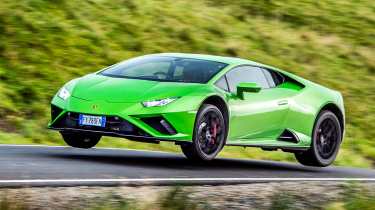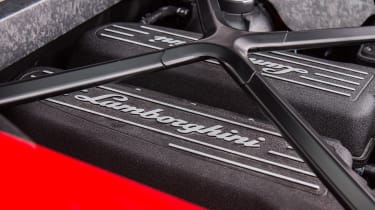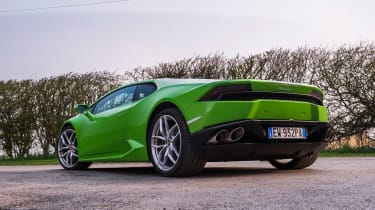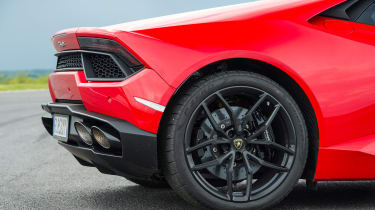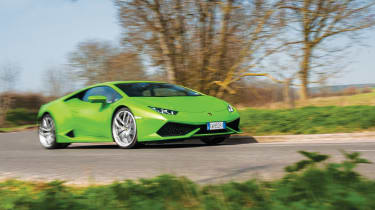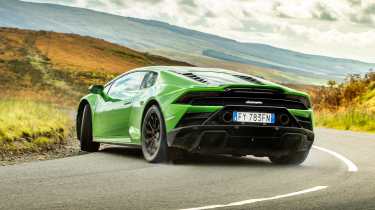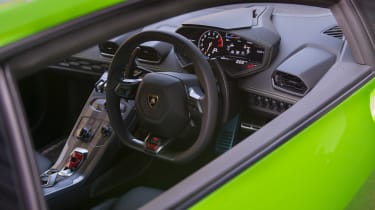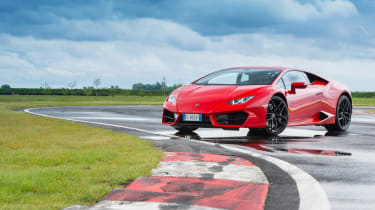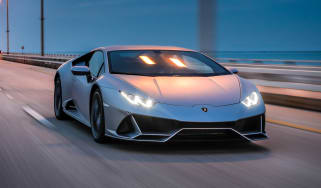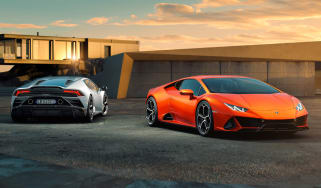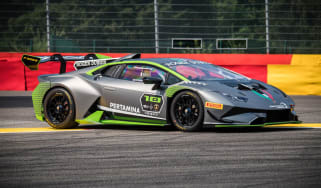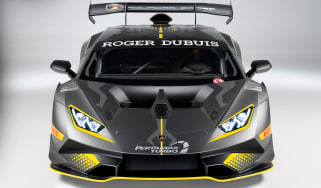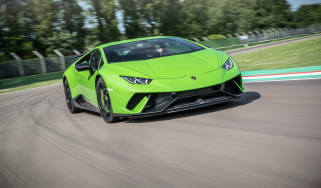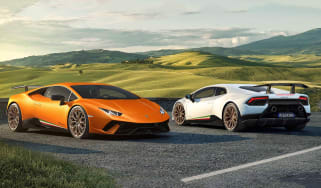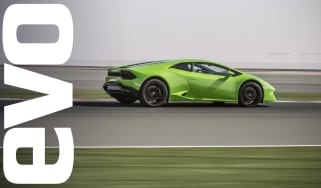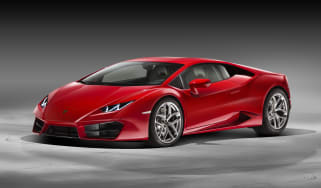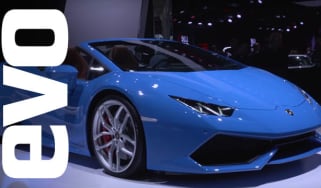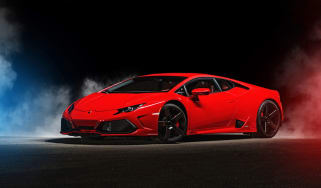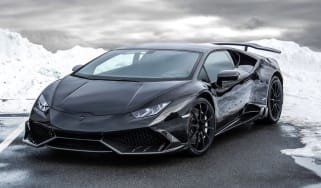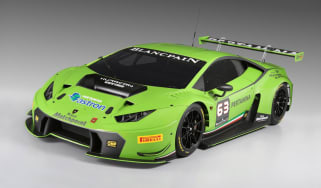Used Lamborghini Huracán (2014-2024) review – last-of-the-line V10 Lambo is one of the very best
Exciting, exotic and eccentric, the Huracán is an all-time great supercar in its final forms – and early examples can be had for new 911 Carrera money
While the Gallardo and Murciélago can be credited for revitalising Lamborghini for the 21st century, the Huracán felt like another big step into modernity when it arrived in 2014. On paper it ticked every box as a junior supercar to rival the likes of Ferrari’s 458 and the McLaren 650S: over 600bhp from Lambo’s signature V10, four-wheel drive, a dual-clutch gearbox (finally) and a totally fresh design and interior. It should've been brilliant but at first, it didn’t quite meet expectations. It was extremely fast, accessible and sounded brilliant but the finer details of how it drove weren’t a match for that sensational engine, or its rivals from Maranello or Woking.
Lamborghini didn’t rest, however. Through various iterations – in particular the Performante, Evo, STO and Tecnica – the Huracán evolved into the car it should’ve always been. It may have shared its aluminium/carbonfibre chassis, V10 engine and dual-clutch gearbox with the Audi R8, but its Italian heritage was clear to see and feel, the Huracán exuding a more flamboyant and aggressive character than the ice-cool Audi. By the end of its life it was a supercar to cover all bases, the STO being able to lap Spa with the intensity and precision of a GT3, and the jacked-up Sterrato delivering those thrills on dirt and gravel as well as tarmac.
Now that the turbocharged, hybrid-assisted Temerario has been ushered in to replace it, the Huracán marks the end of an era - the last of the naturally aspirated V10 breed that began with the Gallardo over two decades ago. Fitting, then, that the Huracan went out as one of our favourite modern era Lambos, and one of the all time great supercars.
Engine, gearbox and technical highlights
- Stunning V10 engine, mated with Lambo’s first dual-clutch
- Iterative chassis upgrades from Performante to Evo, STO and Tecnica
- No turbos or batteries in sight
More reviews
In-depth reviews
Reviews
Like its Gallardo predecessor, the Huracán’s drivetrain is centred around a V10 engine co-developed by parent company Audi. This 5.2-litre V10 is the second major development of this engine and is shared with the Audi R8. Despite boasting similar figures, the Huracán was developed to feel edgier and angrier, with Lamborghini specific engine mapping, intake and exhaust systems. Though revs to well beyond 8000rpm fall some way short of the Temerario’s 10,000rpm V8, the new car can’t match the Huracán’s full-bodied V10 howl.
Unlike rivals from McLaren, the Huracán isn’t built around a carbon tub, but a mixed carbon/aluminium structure that’s 50 per cent more torsionally rigid than the Gallardo’s shell. The launch car tipped the scales at 1422kg, but that’s a dry weight figure with the lightest possible options. Variable Dynamic Steering was an option, with MagneRide electromagnetic dampers that adapt to the road and your driving.
The use of a dual-clutch gearbox was a first for Lamborghini, the seven-speed unit being shared with the R8 and presenting a massive leap over Lamborghini’s single-clutch units. The Huracán was initially four-wheel drive only, the system using an electronically controlled clutch rather than the Gallardo’s viscous coupling and splitting torque 30/70 front-to-back, with the ability to send everything to the rear if needed. Early cars developed 602bhp and 413lb ft of torque, good for a 0-62mph time of 3.2sec. A rear drive version was introduced later with a lower 572bhp output and 3.6sec 0-62mph time.
Then came the first of the hardcore models, the Performante. With added aero, forged carbon components, revised steering, retuned suspension and an uprated 631bhp powertrain, it was effectively a Huracán ‘GT3’. It remained four-wheel drive and dipped just under the 3sec mark in the sprint to 62mph.
The Huracán was comprehensively updated in 2019 to become the Evo, taking learnings from the Performante and being boosted to the same 631bhp. Its 0-62mph time matches that of the Performante, and it also gained a new electronic brain to integrate the chassis systems into one central computer, making the dynamics more predictable and intuitive. As before, four-wheel drive came as standard but rear-drive – and a drop-top Spyder version – were offered too. Four-wheel drive modes had rear-wheel steering, but rear-driven models did not.
The Huracán got an even more radical makeover when the STO arrived in 2021. The name stands for Super Trofeo Omologata, referring to Lambo’s one-make race series, and motorsport pours from every seam of the STO. It works the air with a radically redesigned body made mostly from carbon, resulting in 53 per cent more downforce than the Evo. Wider tracks, retuned suspension and new carbon ceramic brakes lend it more towards track work too. It’s lighter than standard too (helped by being rear-drive only) at 1339kg dry, although the V10 is still capped at 631bhp. 0-62mph comes up in 3sec flat.
The Tecnica, meanwhile, was a mix of the STO and Evo recipes. The bodywork was restyled to generate more downforce and less drag than the Evo, while the chassis gained more aggressive tuning without going to extreme STO levels. It’s again rear-drive with 631bhp, but 0.2sec slower to 62mph than the STO.
It’s hard to conceive of a wilder Huracán than the STO, but the model’s last hurrah – the Sterrato – was just that. An off-road supercar in a similar mould to the Porsche 911 Dakar, it got jacked up suspension, body cladding, a new intake snorkel and all-terrain tyres. The V10 generates 602bhp, giving a 0-62mph of 3.4sec, but the top speed is limited to 162mph rather than the 200mph+ figure of most other Huracáns, as the off-road setup harms stability at very high speeds.
Driver’s note
‘The Evo is so much more convincing than an R8 V10 RWD. Sharper, more direct, more intense and more immediate, it’s just as you’d hope it would be. The engine is spectacular - like it’s powered by nitroglycerin, not gasoline.’ – Richard Meaden, evo editor-at-large, who tested the Lamborghini Huracán Evo RWD on road and track in the UK
Performance, ride and handling
- One of the all-time great engines, with a chassis to match in later versions
- STO has stunning precision and adjustability
- Dynamic Steering best avoided
The Huracán has all the makings of a stunning junior supercar, but early examples split opinion. They could feel sublime on one journey and then mildly frustrating the next, particularly when fitted with the inconsistent variable ratio Dynamic Steering. The good news is that without this system the Huracán is much more cohesive, and lets you access the joys of its chassis and engine more freely.
And what an engine. Normally aspirated with no hybrid augmentation, the response and purity of the V10 is utterly addictive, the sound other-wordly. There’s staggering ferocity as it rips through the revs, and so sharp is its sound and response that the performance actually feels more vivid than some more muted, modern turbocharged supercars. Despite the higher revs required to extract the engine’s considerable performance, it’s never, ever a chore to do so.
The Huracán’s dual-clutch gearbox was a first for Lamborghini, and it slips up and down the gears with the refinement of any other VAG group transmission. Then at full attack the shifts are fast and sharp, almost feeling like the gear’s gone in before you’ve pulled the paddle. It’s a world away from the shunty single-clutch ‘box in an Aventador. In fact the whole drivetrain is more enjoyable, because the V10 also sounds that bit cleaner and more musical from inside the car compared to an Aventador’s V12.
Dynamically, the Huracán doesn’t have the hyper agility of a Ferrari, but its responses are intuitive and keen. The steering weighting changes as you ratchet up through Strada, Sport and Corsa modes on the ANIMA switch. However, on the road, Corsa effects too great a change on the (optional) magnetic dampers and the ride becomes way too stiff, so you tend to find yourself in Sport. That means quite light steering and, on damp roads, a little more weight might be nice. It takes time to trust the front end because you don’t have weight to lean against, and it’s not the most feelsome of systems.
In fact, it does provide the right messages just when you need them – near the limit – but such are the Huracán’s limits that you almost never find them on the road. Even when you go looking. It is an extraordinary car in terms of acceleration, grip and traction, and a very, very different experience to a mid-engined Ferrari or McLaren. It’s unnaturally, unsettlingly fast across the ground, and the four-wheel drive system gives it a distinct advantage in poor weather.
What it isn’t is as expressive as the very best supercars, the balance leaning towards understeer rather than being truly playful. Subsequent versions like the Evo RWD changed that, unlocking a more intuitive and adjustable side to the dynamics, then with the STO, the Huracán took on a dramatic new edge. It’s much more finely honed than the early cars, so pure, precise and intense. Yet there’s malleability to the handling that lets you work in the zone between grip and slip with real confidence. That new sense of purpose combines with the all-consuming V10 in an unforgettable whole. Perhaps the only remaining snags in the last-of-the-line Huracáns is that there’s no individual mode to mix and match your preferred drive mode settings, and the ceramic brakes – they’re tricky to modulate smoothly and though outright power is strong, they can fade under really hard abuse.
Speaking of abuse, the Sterrato is designed to take pretty much anything you can throw at it with raised off-road biased suspension, body protection and four-wheel drive. It’s a Huracán for the rough stuff, and while the concept sounds incongruous on paper, there’s plenty to be said for the unique character it brings to the table. It’s a supercar that rolls and heaves on its springs, laps up bumps and gives you freedom to feel it moving at lower speeds on its off-road rubber. In this sense it has a wider operating window than normal supercars and feels especially suited to UK roads, but some will crave the added response, sharpness and higher ultimate rewards of the Tecnica or STO. Either way, we’re glad it exists, and that the Huracán fulfilled its full, stunning potential by the end of its life.
Driver’s note
‘I’ve fallen for the Tecnica in a big way. The unbelievable intensity of the engine, the sublime gearbox, the way it’s precise and exploitable enough to be driven like an old Mk2 Escort, even when it rains. There are objectively better supercars, but I’m not sure there’s one I want to own more.’ – Yousuf Ashraf, evo senior staff writer, who tested the Lamborghini Huracán Tecnica on the road in the UK
MPG and running costs
Lamborghini and low running costs have never been bedfellows, so like all its rivals, the Huracán is unlikely to appeal to the sort of people who wince at a £4 cup of coffee. Running costs are set to be steep due to the specialised nature of the vehicle, but the costly clutch replacements associated with the old single-clutch semi-automatic are now a thing of the past.
As for fuel consumption, we had the joy of living with an Evo Spyder for six months before it went off sale, in which time our average fuel economy was 16.8mpg. Ouch. Even in context of its rivals the Huracán is a thirsty supercar, but if that’s the trade-off for the purity and sound of its non-turbo, non-hybrid V10, it’s one we’re willing to make.
Interior and technology
It's been over 20 years since Audi purchased Lamborghini during VW’s spending spree in the late nineties, so it’s not such a surprise to see the Audi influence inside the Huracán. You’ll notice it in the switchgear and the digital dash, which is Lamborghini’s interpretation of Audi’s virtual cockpit. It still feels unmistakably like a Lambo, however, with the bespoke cabin architecture featuring a number of Sant’Agatan cues, like the starter button that lies beneath a fighter jet style flip-top cover.
If you were after a subtle driving environment, this probably isn’t the supercar for you, but with those German foundations, it is easier to operate than Lambos of old. Which, admittedly, isn’t saying much. There are still quirks to get used to, such as the wheel mounted indicator switches and the portrait infotainment touchscreen fitted to later models, which is befuddling to use and mounted low down, away from your line of sight.
Space is a little hard to come by too, and those steeply raked screens front and rear mean that outward visibility is poor, even by supercar standards. The seats lack the comfort and support of the best, too.
Price and rivals
When new, the cheapest Huracán came in at around £160,000 – £25k more than the closely related Audi R8 V10 Plus, a car that had more standard equipment, power and standard carbon ceramic brakes. Spending an extra £25,000 got you the more powerful LP 610-4, pulling the Huracán into battle with the Ferrari 488 GTB and McLaren 720S – cars that outclassed it in dynamic and performance terms.
Towards the end of its life the price took a bigger hike, to over £210k for the Tecnica, £230k for the Sterrato and in excess of £250k for the STO. But by this point the Huracán had matured into a genuinely stellar package with unique appeal next to its turbocharged and hybrid rivals.
Today, those latter three models are the most sought after. Low mileage Tecnicas have held their value at around £200k, STOs are yet to dip below a quarter of a million and the cheapest Sterratos are offered for around £220k. At that money they’re firmly in the big leagues of nearly new 992 GT3 RSs, lightly used McLaren 750Ss and brand new supercars like the Maserati MCPura.
At the other end of the spectrum, the most affordable early four-wheel drive Huracáns sit at around the £100k mark, with Performantes and Evos splitting the difference at around £170k. That’s base 911 Carrera money and new Aston Martin Vantage territory, respectively.

